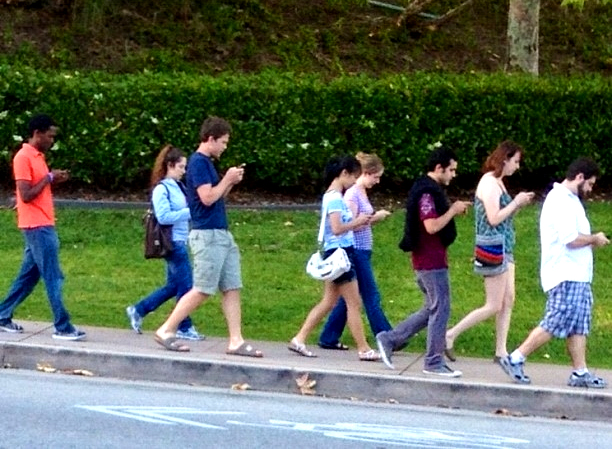Waldorf News
The eZombie at Your Table: A quiet cry

By DEVRA DAVIS
Our fascination with zombies, vampires and sci-fi creatures may be a quiet cry to find ways to avoid becoming heartless sci-fi monsters ourselves.
More suited to a sci-fi flick than reality, a startling epidemic of young people with smartphone-addled brains is on the rise, and the long-term consequences might be far worse than you or I could imagine. Reporting that one in five students are addicted to their smartphones, South Korea, the world’s most tech-savvy nation, is aggressively tackling the problem, establishing more than 100 Internet addiction camps. As the number of young Smartphone users escalates around the globe, educating children and parents about the effects of this increasingly prevalent drug of the future is imperative.
South Korean medical researchers released a recent report that illuminates the experiment in which we are all unwitting participants. Neuroscientists there reported a rise in digital dementia — the tendency of the young to be so obsessed with smartphones that they can’t remember phone numbers, produce legible handwriting, or look people in the eye, all signs of a type of brain damage. In a nation where 20 percent of 10 to 19-year-olds spends seven hours a day on smartphones and tablets, exposures are the highest in the world, and reports of lop-sided brain development are increasing. According to the Korean Ministry of Science, the country has more digital devices than people, with many children beginning to use devices as toddlers. Psychiatrist Dr. Byun Gi-Won, of the Balance Brain Center in Seoul, South Korea, explained, “Young people who are heavy technology users are likely to have a properly developed left hemisphere of the brain while the right hemisphere will be unused and underdeveloped.”
The Atlantic Monthly reported that in Korea, a cottage industry of internet addiction treatment centers has surfaced. Meanwhile in the U.S. parents are giving young children cell phones as toys. The Los Angeles School District, along with many others, is making multi-million dollar commitments to the use of wireless digital devices and Google has “gifted” the city of San Francisco with WiFi for major public parks. The growth wireless is taking place with little thought about the long term impact this can have on developing brains, bodies and babies who are growing up in a sea of radiofrequency radiation that is without precedence in human history.

The American Academy of Pediatrics and the group I head, Environmental Health Trust, have long advocated that children need more lap time than screen time. If digital devices must be used to distract a toddler on a long car trip, put them on airplane mode and make sure they remain disconnected from Internet or Wi-Fi. Other handy tips can be found on the ehtrust.org website—all of which come down to one simple notion — distance is your friend; and time is your enemy. Keep calls and connection times as short as possible.
Look around you these days. Young parents are glued to their phones while strolling with their toddlers – some of whom are also zoned into their own electronic devices. Watch youngsters turn crestfallen when a caregiver shifts from playing with them to answer a text or call. See families seated at dinner tables, each immersed in their own screen.
When we strip away from our lives all the electronified trappings and stuff with which we are so preoccupied; when we throw away all those things we now crave and believe we need, what is left is what essentially makes us human. The rush to digitize toddlers and young children flies in the face of what developmental psychologists have long understood. Children learn best by direct human touch and eye contact — from real people not machines.
Perhaps our contemporary fascination with zombies, vampires and sci-fi creatures, from Mary Shelley’s Frankenstein to The Vampire Diaries and World War Z, may be a quiet cry that we find ways to avoid becoming heartless sci-fi monsters ourselves.
Devra Davis is president of Environmental Health Trust and this article originally appeared in USA TODAY. To view at source, click here.
Visit waldorftoday.com for articles and news on Waldorf education and parenting and read some of our latest articles:
“What learning cursive does for your brain: Cursive writing makes kids smarter” Neuroscience proves what Waldorf knows.
“Knitting is more important than handwork” Waldorf in the Huffington Post!
“Student science experiment finds plants won’t grow near wi-fi router” Ninth graders create international awareness.
“Old fashioned play builds serious skills”
And many more articles and news about Waldorf at waldorftoday.com

 Everything a Teacher Needs
Everything a Teacher Needs Jamie York Books, Resources, Workshops
Jamie York Books, Resources, Workshops Bringing Love to Learning for a Lifetime
Bringing Love to Learning for a Lifetime Flexible preparation for your new grade
Flexible preparation for your new grade Waldorf Training in Australia
Waldorf Training in Australia Middle School Science With Roberto Trostli
Middle School Science With Roberto Trostli ~ Ensoul Your World With Color ~
~ Ensoul Your World With Color ~ Full-Time Teacher Education
Full-Time Teacher Education Great books for Waldorf Teachers & Families
Great books for Waldorf Teachers & Families Quality Education in the Heartland
Quality Education in the Heartland Association for a Healing Education
Association for a Healing Education
 Immersive Academics and Arts
Immersive Academics and Arts Waldorf-inspired Homeschool Curriculum
Waldorf-inspired Homeschool Curriculum Caring for All Stages of Life
Caring for All Stages of Life Summer Programs - Culminating Class Trips
Summer Programs - Culminating Class Trips Apply Today: New Cohort Starts Nov. 2025
Apply Today: New Cohort Starts Nov. 2025 Train to Teach in Seattle
Train to Teach in Seattle The Journey is Everything
The Journey is Everything Transforming Voices Worldwide
Transforming Voices Worldwide Space speaks. Its language is movement.
Space speaks. Its language is movement. Roadmap to Literacy Books & Courses
Roadmap to Literacy Books & Courses Bay Area Teacher Training
Bay Area Teacher Training RSS Feeds
RSS Feeds